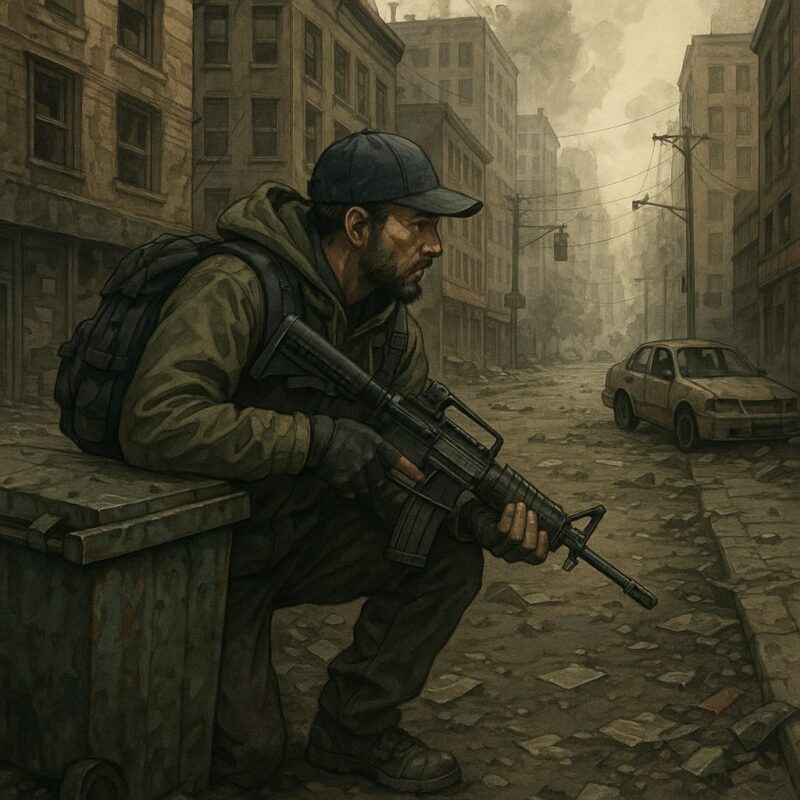Gear, Learning, Life, Prepper's Corner
Urban Survival: Tactics for When the Grid Goes Down in the City
When Comfort Turns to Chaos
Urban life offers convenience, speed, and constant connectivity. But what happens when that delicate infrastructure collapses? Whether it’s due to natural disaster, cyberattack, or civil unrest, a grid-down scenario in the city turns every modern luxury into a liability. No lights. No cell service. No clean water. And danger at every intersection.
For preppers and tactically-minded civilians, surviving in an urban environment without power isn’t just about having the right gear — it’s about knowing how to move, think, and adapt in a high-density, resource-depleted environment. This guide breaks down essential urban survival tactics to keep you and your loved ones safe when the city turns on itself.
Urban Survival vs. Rural Survival: What’s the Difference?
Rural survival usually gives you room to breathe — forests, creeks, and time. Urban survival, on the other hand, is tight, aggressive, and loud. You’re dealing with:
- High population density (which means more competition for fewer resources)
- Greater likelihood of looting, violence, and civil unrest
- Limited escape routes
- Heavily controlled law enforcement zones or total absence of law and order
Your survival strategy must reflect that difference. You can’t just bug out into the woods — you need an actionable plan for surviving where you are, in the middle of the chaos.
The First 72 Hours: Critical Urban Priorities
When the grid drops, most people won’t panic immediately. There’s a window of opportunity — maybe a few hours or a day — when you can make your most critical moves. Here’s what to prioritize:
1.
Water
Water is your #1 concern. The city water supply may fail quickly, especially if it’s electrically pumped. Every prepper should know how to:
- Locate water from building systems, toilets (not the bowl), and rooftop tanks
- Purify water using portable filters, boiling, or chemical treatments
- Cache water ahead of time in bathtubs, collapsible bladders, or sealed drums
2.
Security
With power out, the rule of law starts to decay fast. Looting, robberies, and random acts of violence increase. You must:
- Lock down your apartment or shelter (reinforce doors, blackout windows)
- Maintain low visibility — no loud generators, no fires in windows
- Be prepared to defend yourself. A concealed shoulder holster with a reliable sidearm (like shown in the image) is a solid urban option.
3.
Communication
Phones and internet may die fast, and rumors will fly. Stay ahead by:
- Having battery-powered radios for AM/FM and weather updates
- Pre-arranged rendezvous points with family or team members
- Using HAM radios or walkie-talkies for short-range communication
Essential Urban Survival Gear
Every prepper should have a dedicated Urban Bug-Out Bag (UBOB) tailored for city conditions. Here’s what that should include:
- N95 masks or half-face respirators (smoke, tear gas, dust)
- Compact bolt cutters or lock bypass tools (for accessing locked exits)
- Multitool and pry bar
- LED flashlight with red filter (preserve night vision)
- Cash in small bills (ATMs will be down)
- Map of the city (digital GPS won’t help without satellites)
Also, think clothing. You need to blend in. No tactical camo. Gray man is the goal — neutral hoodie, comfortable pants, and quality boots that don’t scream “prepper.”
Bug In or Bug Out? The Critical Urban Decision
One of the most important choices you’ll face in a grid-down situation is whether to bug in (stay put and fortify your current location) or bug out (evacuate to a safer zone). In an urban environment, this decision needs to be made quickly, and it should be based on:
Bug In If:
- You have sufficient supplies (food, water, medical) for at least 7–10 days.
- Your shelter is secure, discreet, and defensible.
- There’s no immediate threat (riots, fires, flooding, etc.).
- Your area is relatively quiet and residential.
Bug Out If:
- You’re in a high-crime or densely populated zone.
- Supplies are limited and running out fast.
- Your building is compromised or too exposed.
- You’re isolated and have no local support network.
Always have a bug-out route planned in advance — preferably multiple routes with backup paths. In an urban setting, your car might become useless if roads are blocked, so prepare to move on foot.
Urban Escape Routes: Thinking Like Water
You can’t depend on GPS or traffic apps when the grid is down. Escaping a city means moving with purpose and minimal detection. Here’s how:
- Avoid main roads. They’ll be crowded, jammed, and possibly targeted.
- Use service alleys, drainage tunnels, parking garages, skywalks, and other forgotten infrastructure.
- Study your city’s infrastructure maps in advance. Learn the hidden pathways.
- Travel light. Every ounce matters when you’re hoofing it under stress.
Think like water — move through the cracks, avoid resistance, and flow where others can’t.
Long-Term Urban Survival Strategies
If bugging out isn’t an option, and the grid stays down for weeks, you need a plan that goes beyond the initial scramble.
1.
Sourcing Food
Supermarket shelves will empty fast. You need:
- Pre-stocked MREs, freeze-dried meals, canned goods
- The ability to cook without power — camp stove, Sterno cans, alcohol burner
- Knowledge of urban foraging: rooftop gardens, vending machines, abandoned pantries
- Barter items: tobacco, alcohol, ammo, lighters — things people trade when SHTF
2.
Power and Lighting
Solar power becomes king. Keep:
- Foldable solar panels
- USB battery banks
- Rechargeable headlamps
- Candles and glow sticks as backup
Be cautious with light at night — black out windows and use red light mode to avoid drawing attention.
3.
Health & Hygiene
Sanitation breaks down fast in cities. Garbage piles up. Water stagnates. Disease spreads. Prevent it by:
- Stocking wet wipes, hand sanitizer, garbage bags, bleach
- Creating a bucket toilet system with sawdust or kitty litter
- Having basic first aid supplies and meds
- Knowing how to treat wounds without a hospital
Training Matters More Than Toys
Gear helps, but knowledge is king in survival. Know how to:
- Navigate without a phone
- Administer basic trauma care
- Stay hidden and undetected
- Deescalate conflicts or disappear into a crowd
Urban survival is about thinking fast, staying calm, and acting smart. Train now — don’t wait for the grid to fall.
Final Word: Own the Chaos
When the power goes out and panic sets in, most people will be caught flat-footed. You won’t be. With the right mindset, gear, and planning, you’ll own the chaos — not be owned by it.
Whether you’re a prepper, a tactical gearhead, or just someone who refuses to rely on systems you can’t control, urban survival is a game of adaptability. Gear up, map out, and stay ready.


